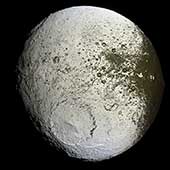
Saturn VI
Iapetus [eye-AP-i-tus] is one of the stranger moons of Saturn. Its density is similar to that of Rhea, indicating that it has a small allotment of rocky materials. Its leading side is dark with a slight reddish color while its trailing side is bright. The dark surface might be composed of matter that was either swept up from space or oozed from the moon's interior. The real reason is still unknown. The dark material might be a thin layer of organic material perhaps similar to the complex substances found in the most primitive meteorites. However, there are no bright rimed craters present on the dark hemisphere. If the dark material is thin, it must be constantly renewed since a meteor impact would punch through the layer to reveal brighter surface material.
The dark material may have originated from Phoebe, which has a very low albedo. Micrometeor impacts could kick dark matter off Phoebe which is then swept up by Iapetus. (Phoebe, however, has a slightly different color from that of the dark surface of Iapetus.) The fact that the material is on the leading hemisphere seems to support this theory. On the other hand, the dark material seems to be concentrated in crater floors. This would indicate an internal origin. Since Iapetus is so far from Saturn, it may have formed with methane or ammonia ice in its interior. The dark material could be explained by eruptions of methane from its interior. This theory is supported by a dark ring of material about 100 kilometers (62 miles) in diameter that straddles the border between the leading and trailing hemispheres of Iapetus. Such rings formed on the Moon and on Mars when dark volcanic material flowed into impact craters and filled around the central peak.
| Iapetus Statistics | |
|---|---|
| Discovered by | Giovanni Domenico Cassini |
| Date of discovery | 1671 |
| Mass (kg) | 1.88e+21 |
| Mass (Earth = 1) | 3.1459e-04 |
| Equatorial radius (km) | 730 |
| Equatorial radius (Earth = 1) | 1.1446e-01 |
| Mean density (gm/cm^3) | 1.21 |
| Mean distance from Saturn (km) | 3,561,300 |
| Rotational period (days) | 79.33018 |
| Orbital period (days) | 79.33018 |
| Mean orbital velocity (km/sec) | 3.27 |
| Orbital eccentricity | 0.0283 |
| Orbital inclination (degrees) | 14.72 |
| Escape velocity (km/sec) | 0.586 |
| Visual geometric albedo | 0.2 |
| Magnitude (Vo) | 10.2-11.9 |
| Views of Iapetus |
|---|
All Iapetus Pictures
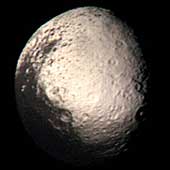 Color Image of Iapetus
Color Image of Iapetus
This color image of Iapetus was created by combining Voyager 2 image
data taken through orange, green and blue filters. It was acquired on
August 22, 1981. The picture shows a portion of dark material on the left.
The satellite's motion is towards the left.
(Copyright Calvin J. Hamilton)
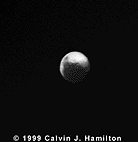 Iapetus Animation
Iapetus Animation
This animation of Iapetus was created from 8 pictures taken on August 22,
1981 by the Voyager 2 spacecraft. It is interesting to note the bright
mountain peaks, located in the dark material, as they move towards the
limb of the satellite.
(Copyright Calvin J. Hamilton)
 The Other Side of Iapetus
The Other Side of Iapetus
Cassini captures the first high-resolution glimpse of the bright trailing
hemisphere of Saturn's moon Iapetus.
This false-color mosaic shows the entire hemisphere of Iapetus (1,468 kilometers, or 912 miles across) visible from Cassini on the outbound leg of its encounter with the two-toned moon in Sept. 2007. The central longitude of the trailing hemisphere is 24 degrees to the left of the mosaic's center.
Also shown here is the complicated transition region between the dark leading and bright trailing hemispheres. This region, visible along the right side of the image, was observed in many of the images acquired by Cassini near closest approach during the encounter.
Revealed here for the first time in detail are the geologic structures that mark the trailing hemisphere. The region appears heavily cratered, particularly in the north and south polar regions. Near the top of the mosaic, numerous impact features visible in NASA Voyager 2 spacecraft images (acquired in 1981) are visible, including the craters Ogier and Charlemagne.
The most prominent topographic feature in this view, in the bottom half of the mosaic, is a 450-kilometer (280-mile) wide impact basin, one of at least nine such large basins on Iapetus. In fact, the basin overlaps an older, similar-sized impact basin to its southeast.
In many places, the dark material--thought to be composed of nitrogen-bearing organic compounds called cyanides, hydrated minerals and other carbonaceous minerals--appears to coat equator-facing slopes and crater floors. The distribution of this material and variations in the color of the bright material across the trailing hemisphere will be crucial clues to understanding the origin of Iapetus' peculiar bright-dark dual personality.
The view was acquired with the Cassini spacecraft narrow-angle camera on Sept. 10, 2007, at a distance of about 73,000 kilometers (45,000 miles) from Iapetus.
The color seen in this view represents an expansion of the wavelengths of the electromagnetic spectrum visible to human eyes. The intense reddish-brown hue of the dark material is far less pronounced in true color images. The use of enhanced color makes the reddish character of the dark material more visible than it would be to the naked eye.
This mosaic consists of 60 images covering 15 footprints across the surface of Iapetus. The view is an orthographic projection centered on 10.8 degrees south latitude, 246.5 degrees west longitude and has a resolution of 426 meters (0.26 miles) per pixel. An orthographic view is most like the view seen by a distant observer looking through a telescope.
At each footprint, a full resolution clear filter image was combined with
half-resolution images taken with infrared, green and ultraviolet spectral
filters (centered at 752, 568 and 338 nanometers, respectively) to create
this full-resolution false color mosaic.
(Courtesy NASA/JPL/Space Science Institute)
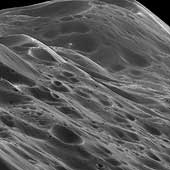 The Himalayas of Iapetus
The Himalayas of Iapetus
This stunning close-up view shows mountainous terrain that reaches about
10 kilometers (6 miles) high along the unique equatorial ridge of Iapetus. The view was acquired during Cassini's only close flyby of the two-toned Saturn moon.
Above the middle of the image can be seen a place where an impact has exposed the bright ice beneath the dark overlying material.
The image was taken on Sept. 10, 2007, with the Cassini spacecraft
narrow-angle camera at a distance of approximately 3,870 kilometers (2,400
miles) from Iapetus. Image scale is 23 meters (75 feet) per pixel.
(Courtesy NASA/JPL/Space Science Institute)
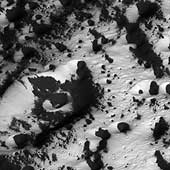 Coated Craters
Coated Craters
Cassini surveys a bright landscape coated by dark material on Iapetus.
This image shows terrain in the transition region between the moon's dark
leading hemisphere and its bright trailing hemisphere. The view was
acquired during Cassini's only close flyby of the two-toned Saturn moon.
The image was taken on Sept. 10, 2007, with the Cassini spacecraft
narrow-angle camera at a distance of approximately 5,260 kilometers (3,270
miles) from Iapetus. Image scale is 32 meters (105 feet) per pixel.
(Courtesy NASA/JPL/Space Science Institute)
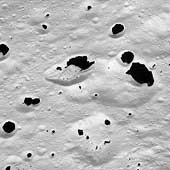 Inky Stains on a Frozen Moon
Inky Stains on a Frozen Moon
Dark material splatters the walls and floors of craters in the surreal,
frozen wastelands of Iapetus. This image shows terrain in the transition
region between the moon's dark leading hemisphere and its bright trailing
hemisphere. The view was acquired during Cassini's only close flyby of the
two-toned Saturn moon.
The image was taken on Sept. 10, 2007, with the Cassini spacecraft
narrow-angle camera at a distance of approximately 6,030 kilometers (3,750
miles) from Iapetus. Image scale is 36 meters (118 feet) per pixel.
(Courtesy NASA/JPL/Space Science Institute)
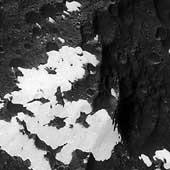 The "Voyager" Mountains
The "Voyager" Mountains
Cassini zooms in, for the first time, on the patchy, bright and dark
mountains originally identified in images from the NASA Voyager spacecraft
taken more than 25 years earlier. The image was acquired during Cassini's
only close flyby of Iapetus, a two-toned moon of Saturn.
The terrain seen here is located on the equator of Iapetus at approximately 199 degrees west longitude, in the transition region between the moon's bright and dark hemispheres. North is up.
The image was taken on Sept. 10, 2007, with the Cassini spacecraft
narrow-angle camera at a distance of approximately 9,240 kilometers (5,740
miles) from Iapetus. Image scale is 55 meters (180 feet) per pixel.
(Courtesy NASA/JPL/Space Science Institute)
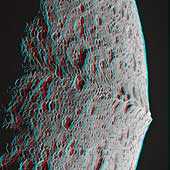 3D Mountain Ridge
3D Mountain Ridge
This 3D image shows a mountain ridge on Iapetus. It was taken on September 10, 2007, with the Cassini spacecraft
narrow-angle camera at a distance of approximately 5,620 kilometers
from Iapetus.
(Copyright Calvin J. Hamilton)
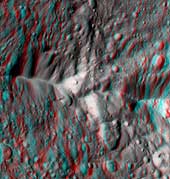 3D Close Up
3D Close Up
A 3D close up of a mountain range on Iapetus.
The image was taken on September 10, 2007, with the Cassini spacecraft
wide-angle camera at a distance of approximately 1,722 kilometers
from Iapetus.
(Copyright Calvin J. Hamilton)
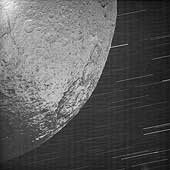 Iapetus by Saturn Shine
Iapetus by Saturn Shine
This almost surreal view of Iapetus was acquired by Cassini about 10
minutes after the spacecraft's closest approach to the icy moon during
a close flyby on New Year's Eve 2004.
The image shows Iapetus' surface illuminated by reflected light from Saturn (not by the Sun) and is the highest resolution view acquired to date of this part of Iapetus' surface.
Compared to the approximately one second exposure times used for imaging Iapetus' sunlit side, this view required a very long exposure time of 82 seconds. Cassini was designed to pivot while moving in order to keep its cameras and other remote sensing instruments pointed 'on target' with great precision. Consequently, despite the large relative speed between Iapetus and the spacecraft during this long exposure -- about 2 kilometers per second or almost 4,500 miles per hour at closest approach -- the image of the moonís surface is un-smeared (although the background stars are smeared).
This image reveals a heavily cratered surface and shows the boundary between Iapetus' bright trailing hemisphere and Cassini Regio -- a large, dark region that covers the leading hemisphere of the moonís surface. Some of the dark material appears to have collected inside the rim of a large impact structure about 250 kilometers across (155 miles) that lies just beyond the edge of the dark region (seen here near the right of the image). NASA's Voyager images (see PIA02268) this feature appeared as a dark 'moat' and had been hypothesized to be an impact structure. The recent images from Cassini confirm an impact origin for this feature.
In contrast, the origin of the dark material is currently unknown and the recent images have sparked exciting debates among Cassini imaging scientists. Some characteristics of the dark region revealed in this and other images taken during the encounter suggest that dark material from elsewhere in the Saturnian system -- perhaps the result of an impact on another nearby moon -- has coated this side of Iapetus with a relatively thin layer. However, an internal origin for the material has not been ruled out and, if correct, may be related to the long equatorial ridge discovered in Cassini images to span Cassini Regio.
Regardless of its origins, the dark material appears to lie on top of other
geologic features seen on Iapetus thus far, implying that the event which
formed the dark coating occurred later in Iapetus' history. A closer
encounter with this moon later in the Cassini mission (September 2007)
may reveal more detail and help answer the question of the origin and
age of the dark material on Iapetus.
(Courtesy NASA/JPL/Space Science Institute)
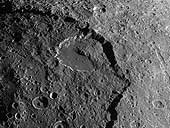 Giant Landslide on Iapetus
Giant Landslide on Iapetus
A spectacular landslide within the low-brightness region of Iapetus's surface
known as Cassini Regio is visible in this image from Cassini. Iapetus is one
of the moons of Saturn.
The landslide material appears to have collapsed from a scarp 15 kilometers high (9 miles) that forms the rim of an ancient 600 kilometer (375 mile) impact basin. Unconsolidated rubble from the landslide extends halfway across a conspicuous, 120-kilometer diameter (75-mile) flat-floored impact crater that lies just inside the basin scarp.
Landslides are common geological phenomena on many planetary bodies,
including Earth and Mars. The appearance of this landslide on an icy satellite
with low-brightness cratered terrain is reminiscent of landslide features that
were observed during NASA's Galileo mission on the Jovian satellite Callisto.
The fact that the Iapetus landslide traveled many kilometers from the basin
scarp could indicate that the surface material is very fine-grained, and
perhaps was fluffed by mechanical forces that allowed the landslide debris
to flow extended distances.
(Courtesy NASA/JPL/Space Science Institute)
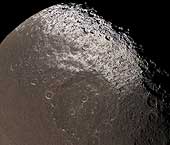 Dark-stained Iapetus
Dark-stained Iapetus
This near-true color view from Cassini reveals the colorful and intriguing
surface of Saturn's moon Iapetus in unrivaled clarity.
This image shows the northern part of the dark Cassini Regio and the transition zone to a brighter surface at high northern latitudes. Within the transition zone, the surface is stained by roughly north-south trending wispy streaks of dark material. The absence of an atmosphere on Iapetus means that the material was deposited by some means other than precipitation, such as ballistic placement from impacts occurring elsewhere on Iapetus, or was captured from elsewhere in the Saturn system.
Iapetusís north pole is not visible here, nor is any part of the bright trailing hemisphere.
Images taken with infrared (centered at 930 nanometers), green (568
nanometers), and ultraviolet light (338 nanometers) filters were combined
to create this image. The view was obtained with the Cassini spacecraft
narrow angle camera on Dec. 31, 2004, at a distance of about 172,900
kilometers (107,435 miles) from Iapetus. Resolution achieved in the
original image was 1 kilometer (0.6 miles) per pixel. The image has been
magnified by a factor of two to aid visibility of surface features.
(Courtesy NASA/JPL/Space Science Institute)
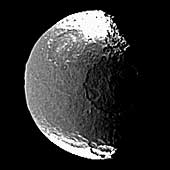 Details in the Dark
Details in the Dark
This view shows one of the huge impact basins on the terminator of
Saturn's moon Iapetus and a smaller, but still fairly large, crater near
the southern bright-dark boundary. Just visible near the western limb, in
the dark territory of Cassini Regio, is the moon's mysterious equatorial
ridge. The ridge was discovered in Cassini images (see PIA06166) and
reaches 20 kilometers (12 miles) high in places.
This view shows principally the leading hemisphere on Iapetus. North is up and tilted 15 degrees to the right. Iapetus is 1,468 kilometers (912 miles) across.
The image was taken with the Cassini spacecraft narrow-angle camera on
March 19, 2005, through spectral filters sensitive to wavelengths of
infrared light centered at 752 nanometers. The view was acquired at a
distance of approximately 1.4 million kilometers (880,000 miles) from
Iapetus and at a Sun-Iapetus-spacecraft, or phase, angle of 70 degrees.
Resolution in the original image was 8 kilometers (5 miles) per pixel.
(Courtesy NASA/JPL/Space Science Institute)
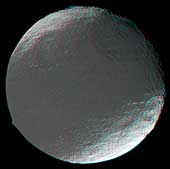 Iapetus in 3D
Iapetus in 3D
This stereo view of Iapetus was created by combining two Cassini images,
which were taken one day apart. The view serves mainly to show the
spherical shape of Iapetus and some of the moonís topography.
The prominent linear ridge in the center of the dark area -- a place known as Cassini Regio -- marks the equator quite closely. The ridge was first discovered in this set of images and was seen at higher resolution in images taken during Cassiniís flyby of Iapetus on New Yearís Eve 2004. Some Cassini imaging scientists have suggested that the ridge may have a causal relationship to the dark material that coats the moonís leading hemisphere. The mountain on the left is part of the ridge, and rises at least 13 kilometers (8 miles) above the surrounding terrain.
The large basin near the terminator (at upper right) was detected in Cassini images from July and has a diameter of about 550 kilometers (340 miles). The large basin at upper left was newly detected in these images. The crater at far right (within the bright terrain) was known from the days of NASA's Voyager missions.
North on Iapetus is towards the upper left. The images were obtained
in visible light with the Cassini spacecraft narrow angle camera on
Dec. 26 and 27, 2004. Cassiniís distance from Iapetus ranged from
880,537 to 716,678 kilometers (547,140 to 445,323 miles) between
the two images, and the Sun-Iapetus-spacecraft, or phase, angle
changed from 21 to 22 degrees. Resolution achieved in the original
images was 5.2 and 4.3 kilometers (3.2 and 2.7 miles) per pixel, respectively.
(Courtesy NASA/JPL/Space Science Institute)

 Saturn
Saturn Hyperion
Hyperion Phoebe
Phoebe